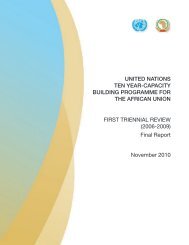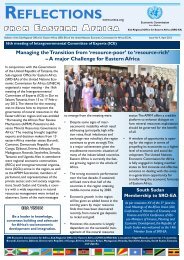A Decade of NEPAD - Economic Commission for Africa - uneca
A Decade of NEPAD - Economic Commission for Africa - uneca
A Decade of NEPAD - Economic Commission for Africa - uneca
Create successful ePaper yourself
Turn your PDF publications into a flip-book with our unique Google optimized e-Paper software.
In addition to economic re<strong>for</strong>m, peace and stability, and<br />
high commodity prices, the emergence <strong>of</strong> China as a major<br />
market <strong>for</strong> <strong>Africa</strong>n goods and commodities also helped bolster<br />
both manufacturing and natural resource investment.<br />
International banking activity in sub-Saharan <strong>Africa</strong><br />
nearly tripled between 2004 and 2007 when total <strong>for</strong>eign<br />
claims on sub-Saharan economies held by banks reporting<br />
to the Bank <strong>for</strong> International Settlements rose to roughly<br />
US$205 billion at the end <strong>of</strong> 2007. In addition, bond flows<br />
increased by US$7.13 billion between 2006 – 2007 as Nigeria<br />
(US$350 million), Ghana (US$750 million), Gabon<br />
(US$1 billion) and the Seychelles (US$200 million) issued<br />
international bonds <strong>for</strong> the first time. 55<br />
Portfolio equity flows to <strong>Africa</strong>’s equity markets also rose<br />
roughly 100% in 2006, doubling to US$15 billion although<br />
88% <strong>of</strong> these flows went to South <strong>Africa</strong>. Cote d’Ivoire,<br />
Botswana, Ghana, Kenya and Mauritius were the other<br />
exchanges to experience portfolio growth.<br />
In addition to increasing FDI and private capital flows, another<br />
important source <strong>of</strong> capital <strong>for</strong> <strong>Africa</strong>n countries over<br />
the past ten years has been <strong>for</strong>mal and in<strong>for</strong>mally transferred<br />
remittances from <strong>Africa</strong>n “Diasporans” based in North America<br />
and Europe, and from migrant workers on the continent.<br />
<strong>Africa</strong> today has over 30 million people in the Diaspora.<br />
Of all the world’s regions, however, <strong>Africa</strong>’s predominant<br />
migration is the most intra-regional although there is also<br />
significant international migration to <strong>for</strong>mer European<br />
colonial powers such as France, the United Kingdom <strong>of</strong><br />
Great Britain and Northern Ireland, the Netherlands and<br />
Italy, among other countries.<br />
Remittance flows to and within <strong>Africa</strong> approach US$40<br />
billion 56 . Countries in Northern <strong>Africa</strong> (i.e. Morocco,<br />
Algeria and Egypt) are the major remittance receivers on<br />
the continent, although Eastern <strong>Africa</strong>n countries depend<br />
most heavily on these flows, with Somalia standing out as<br />
particularly remittance dependent. For the entire region,<br />
annual average remittances per migrant reach almost<br />
US$1,200 and on a country-by-country average represent<br />
5 per cent <strong>of</strong> GDP and 27 per cent <strong>of</strong> exports.<br />
55 Macias, Jose and Massa, Isabela, The Global Financial Crisis and<br />
sub-Saharan <strong>Africa</strong>: The Effects <strong>of</strong> Slowing Private Capital Inflows on<br />
Growth, <strong>Africa</strong>n <strong>Economic</strong> Conference 2009, Addis Ababa, Ethiopia,<br />
AfDB and ECA, p.2<br />
56 www.ifad.org/remittances/maps/africa.htm<br />
4. <strong>NEPAD</strong> and the <strong>Africa</strong>n Private Sector Today A <strong>Decade</strong> <strong>of</strong> <strong>NEPAD</strong><br />
Remittances to rural areas are significant and predominantly<br />
related to intra-regional migration, particularly in Western<br />
and Southern <strong>Africa</strong>. The mobility <strong>of</strong> <strong>Africa</strong>ns within these<br />
regions has been followed by the sending <strong>of</strong> regular amounts<br />
<strong>of</strong> money. Two thirds <strong>of</strong> West <strong>Africa</strong>n migrants in Ghana<br />
remit to rural areas in their countries <strong>of</strong> origin.<br />
However, when compared with other regions, money transfers<br />
to <strong>Africa</strong> are among the most problematic, mainly due<br />
to the two major challenges faced by the continent: high<br />
rates <strong>of</strong> in<strong>for</strong>mality, particularly within the continent, and<br />
a regulatory environment that favours monopolies. Consequently,<br />
transfer costs are higher and remittance senders<br />
obtain less value <strong>for</strong> their money. Most <strong>Africa</strong>n countries<br />
restrict outbound flows <strong>of</strong> money unless used <strong>for</strong> trading<br />
and money transfers to banking depositary institutions.<br />
As a result, in<strong>for</strong>mality emerges as a solution to the need<br />
to remit. Another effect, however, is the persistence <strong>of</strong> monopolies<br />
on transfers by banks and the few money transfer<br />
operators (MTOs). In all <strong>of</strong> Western <strong>Africa</strong>, <strong>for</strong> example,<br />
70 per cent <strong>of</strong> <strong>of</strong>ficial payments are handled by one MTO,<br />
which demands exclusivity in money transfers <strong>of</strong> the banks<br />
Since banks are the only entities allowed to pay money<br />
transfers, all <strong>of</strong>ficial flows end up being handled by a small<br />
group <strong>of</strong> financial institutions that rely on less than four<br />
MTOs. Migrants in South <strong>Africa</strong> are also faced with significant<br />
regulatory restrictions on sending money, and<br />
thus rely on in<strong>for</strong>mal networks. Because regulatory environments<br />
<strong>of</strong>ten prevent other non-banking financial<br />
institutions from making transfers, or restrict outbound<br />
transfers, financial access is also a casualty. As few institutions<br />
participate in the transfers, and banks do not cater to<br />
lower-income individuals, financial access among <strong>Africa</strong>n<br />
senders and recipients is relatively low. In some countries,<br />
<strong>for</strong> example South <strong>Africa</strong>, barriers to entry relate to legal<br />
status, thus disenfranchising migrants. Other countries,<br />
<strong>for</strong> example Kenya, are seeking to increase financial access<br />
by leveraging remittance transfers through the use<br />
<strong>of</strong> mobile telephony.<br />
In 2010, remittances to <strong>Africa</strong> totalled close to US$40<br />
billion. Dubbed DDI 57 (or Diaspora Direct Investment),<br />
these remittances were, in 2007, greater than overseas development<br />
assistance in Botswana, Cote d’Ivoire, Lesotho,<br />
57 Thomas, D. and Ardovino, M., Diaspora Direct Investment: The<br />
Untapped Resource <strong>for</strong> Development, U.S. Agency <strong>for</strong> International<br />
Development, May 19, 2009<br />
43







